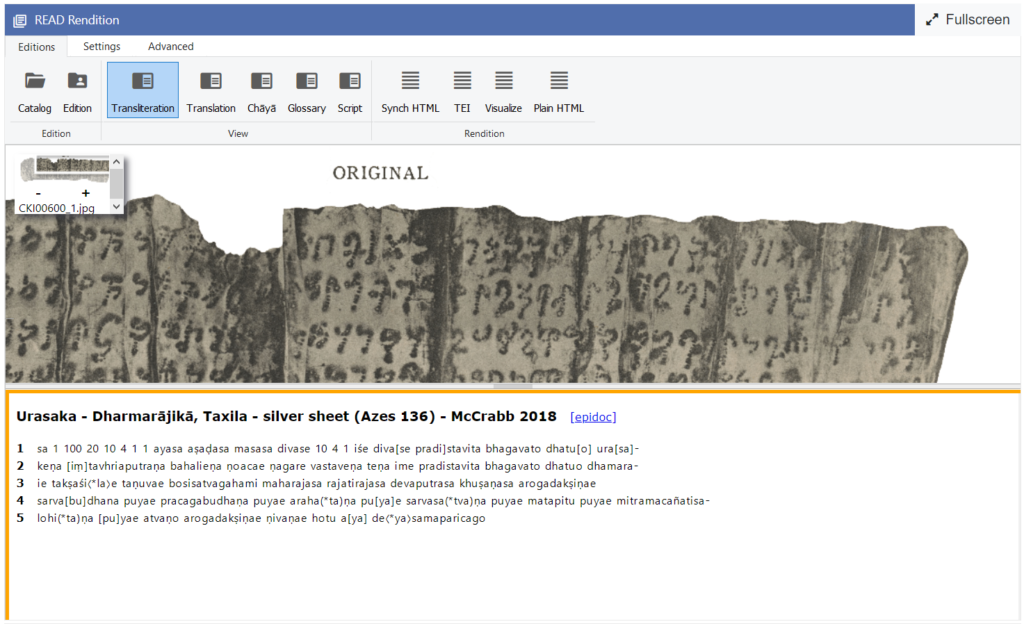This silver scroll was unearthed by Sir John Marshall in 1914 in a chamber to the west of the Dharmarājīka Stūpa in Taxila, Pakistan and is now in the collection of the National Museum in New Delhi, India. The inscription is dated to year 136 of the Azes era, 89 CE, during the reign of the first Kushana king, Kujula Kadphises. It was found, together with a small gold casket and some minute bone relics, inside a silver vase inside a steatite vessel. The collapse of the chamber roof had crushed both the vessel and the vase but left the casket and the scroll largely intact. The scroll, of thin metal, was tightly rolled with the inscribed surface inwards. The cleaning of copper efflorescence from the verso exposed the punctured dots of the lettering as the sheet was unrolled and broken into sections.
Conventional Name Taxila Silver Scroll | Findspot Pakistan, Punjab, Taxila – Dharmarājīka Stūpa – Chir Mound | Archeological Report: Marshall 1914 | Item Rectangular Silver Sheet | Surface Recto | Dimensions Height: 3.5 Width: 15.9 | Date Azes 136 | Collection | Current Location National Museum, New Delhi, India – 8789 Dh’ 12-65 | Language/Script Gāndhārī/Kharoṣṭḥī
Content Summary
In the year 136 of the Azes era a Bactrian resident of Ṇoaca establishes relics of the Lord in his personal Bodhisattva shrine for the health of the great Kuṣāṇa King and in honor of all Buddhas, sangha, all beings, parents, friends and relatives. The donation is also for his own health and nirvāṇa.
Keywords
Benefit, Buddha, Donation, EraRulerDate, Establishment, Honor
Previous Editions
-
Konow, Sten. 1929. Kharoshṭhī Inscriptions with the Exception of Those of Aśoka. Corpus Inscriptionum Indicarum, Vol. II, Part I. Calcutta: Government of India Central Publication Branch. 51, 70–7
-
Lüders, Heinrich. 1940. “Zu und aus den Kharoṣṭhī‐Urkunden.” Acta Orientalia 18: 15–49.
-
Brough, John. 1962. The Gāndhārī Dharmapada. London Oriental Series, Volume 7. London: Oxford University Press.
Other References
-
Bibliographic details of references to this inscription are available from
(
Gāndhārī Language and Literature
)
Acknowledgements
Research on this edition and production of the digital edition was completed with the generous support of the Prakaś Foundation. The transliteration, translation, chāyā and glossary have been reviewed by Mark Allon and Stephanie Majcher.
Digital publishing by Ian McCrabb
Each digital edition includes background information about the text, a summary of its content, and references to parallel texts and related publications. Users can explore the text, image, and other analysis resources through various preset views from the READ interface, or customize the views themselves.
By developing the text in READ, the text and image are linked such that selecting a syllable, word, or compound in the text or glossary will highlight the associated akṣaras on the manuscript. This allows you to in effect “read” the manuscript as you read the transcribed text, even if you do not know the script.
Users can choose from several preset READ views by selecting the tabs at the top. Each of these convenient arrangements of text and resources is suited to a different experience with the manuscript. For instance, choose the Script view to study the paleography of the manuscript or the Glossary view to study its vocabulary. It is recommended that the user toggles through the default views to gain a holistic perspective of the text.

- Transliteration: Image and transliteration.
- Translation: Transliteration and translation.
- Chāyā: Transliteration and chāyā.
- Glossary: Image, transliteration, and glossary.
- Script: Image, transliteration, and script chart
- Visualize: Visualize the text structure display.
- Synch HTML: Interactive synchronized rendition.
- TEI: EpiDoc TEI rendition.
- Plain HTML: Transliteration in HTML format.
Avś
Be
Ce
Ch.
CPS
DhG
Ee
FJJ
Mahīś
MūSā
Mvu
P
SĀ
SBhV
Se
Skt.
SN
T
Tib.
Vin
Avadānaśataka (ed. Speyer 1906–1909)
Burmese (Chaṭṭhasaṅgāyana) edition
Sri Lankan (Buddha Jayanti Tipiṭaka Series) edition
Chinese
Catuṣpariṣat-sūtra (ed. Waldschmidt 1952–1962)
Dharmaguptaka
European (Pali Text Society) edition
Fobenxing ji jing (T 190)
Mahīśāsaka
Mūlasarvāstivāda
Mahāvastu-avadāna (ed. Senart 1882–1897)
Pali
Saṃyukta-āgama (T 99)
Saṅghabhedavastu (ed. Gnoli 1977–1978)
Thai (King of Siam) edition
Sanskrit
Saṃyutta-nikāya
Taishō 大正 edition
Tibetan
Vinaya

